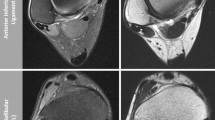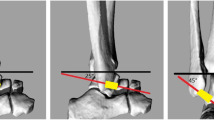Abstract
Objective. To predict clinical outcome after ankle sprains on the basis of magnetic resonance (MR) findings. Design and patients. Twenty-nine consecutive patients (mean age 32.9 years, range 13–60 years) were examined clinically and with MR imaging both after trauma and following standardized conservative therapy. Various MR abnormalities were related to a clinical outcome score. Results. There was a tendency for a better clinical outcome in partial, rather than complete, tears of the anterior talofibular ligament and when there was no fluid within the peroneal tendon sheath at the initial MR examination (P=0.092 for either abnormality). A number of other MR features did not significantly influence clinical outcome, including the presence of a calcaneofibular ligament lesion and a bone bruise of the talar dome. Conclusion. Clinical outcome after ankle sprain cannot consistently be predicted by MR imaging, although MR imaging may be more accurate when the anterior talofibular ligament is only partially torn and there are no signs of injury to the peroneal tendon sheath.
Similar content being viewed by others
Author information
Authors and Affiliations
Rights and permissions
About this article
Cite this article
Zanetti, M., Simoni, C., Wetz, H. et al. Magnetic resonance imaging of injuries to the ankle joint: can it predict clinical outcome?. Skeletal Radiol 26, 82–88 (1997). https://doi.org/10.1007/s002560050198
Issue Date:
DOI: https://doi.org/10.1007/s002560050198




